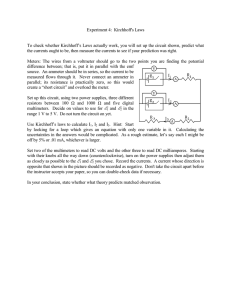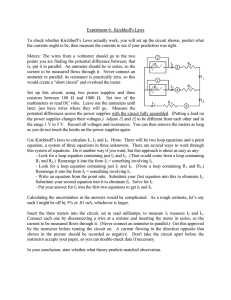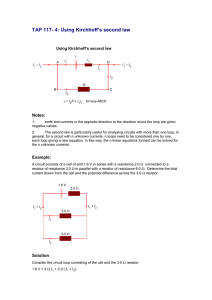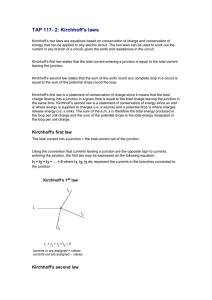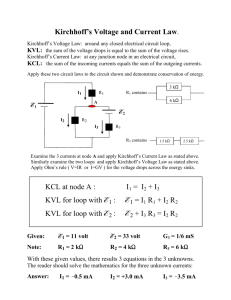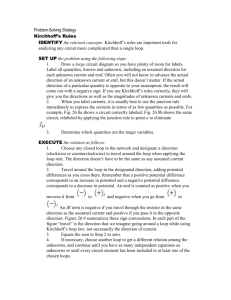Episode 117: Kirchhoff's laws (Word, 158 KB)
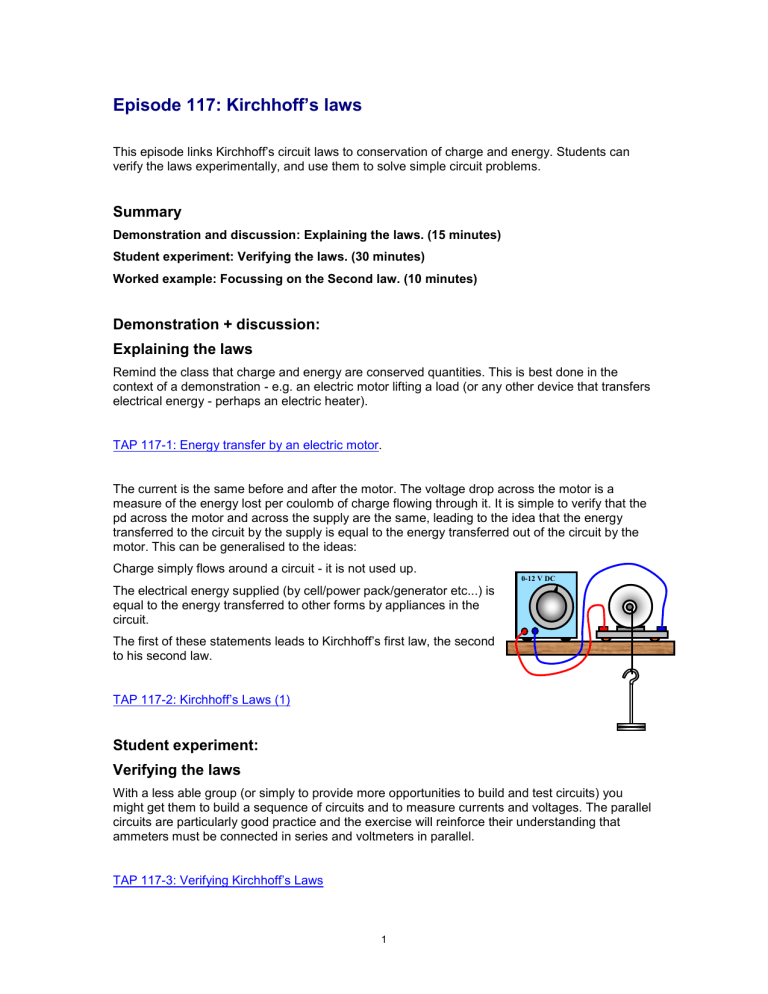
Episode 117: Kirchhoff’s laws
This episode links Kirchhoff’s circuit laws to conservation of charge and energy. Students can verify the laws experimentally, and use them to solve simple circuit problems.
Summary
Demonstration and discussion: Explaining the laws. (15 minutes)
Student experiment: Verifying the laws. (30 minutes)
Worked example: Focussing on the Second law. (10 minutes)
Demonstration + discussion:
Explaining the laws
Remind the class that charge and energy are conserved quantities. This is best done in the context of a demonstration - e.g. an electric motor lifting a load (or any other device that transfers electrical energy - perhaps an electric heater).
TAP 117-1: Energy transfer by an electric motor .
The current is the same before and after the motor. The voltage drop across the motor is a measure of the energy lost per coulomb of charge flowing through it. It is simple to verify that the pd across the motor and across the supply are the same, leading to the idea that the energy transferred to the circuit by the supply is equal to the energy transferred out of the circuit by the motor. This can be generalised to the ideas:
Charge simply flows around a circuit - it is not used up.
The electrical energy supplied (by cell/power pack/generator etc...) is equal to the energy transferred to other forms by appliances in the circuit.
The first of these statements leads to Kirchhoff’s first law, the second to his second law.
TAP 117-2: Kirchhoff’s Laws (1)
0-12 V DC
Student experiment:
Verifying the laws
With a less able group (or simply to provide more opportunities to build and test circuits) you might get them to build a sequence of circuits and to measure currents and voltages. The parallel circuits are particularly good practice and the exercise will reinforce their understanding that ammeters must be connected in series and voltmeters in parallel.
TAP 117-3: Ver ifying Kirchhoff’s Laws
1
Worked example:
Focussing on the second law
Students are unlikely to be required to solve complex problems involving circuits with two or more loops. However, they should be able to apply Kirchhoff’s laws to simple circuits.
The first law is not difficult; the second law is harder. Teach your students to use a finger to trace round a complete loop in a circuit, starting at a source of emf. The first time round, they add up all the emfs (taking account of their directions). The second time round, they add up the values of IR for each component (again, algebraically, and including contributions for internal resistance).
These two quantities are then equal.
Show a worked example on the board.
TAP 117-4: Kirchhoff’s Laws (2)
TAP 117-5: Questions on Kirchhoff’s Laws
2
TAP 117- 1: Demonstration: Energy transfer by an electric motor
A
V M V
A
Apparatus requirements:
dc motor or fan* suitable power supply # two voltmeters ammeter
* Any electrical device will do but it needs to be seen to transfer energy.
# Use a separate switch – that on the power supply may only stop charging an internal capacitor.
If the motor is driving a shaft to raise a load, the motor should be clamped to the bench so that it cannot jump about if it continues to run with the string fully wound.
Meters should be set up so that they can be seen by the class.
Use the meters to show that current is the same before and after the motor, and that the pd across the motor equals the emf across the power supply.
3
TAP 117- 2: Kirchhoff's laws
Kirchhoff's two laws are equations based on conservation of charge and conservation of energy that can be applied to any electric circuit. The two laws can be used to work out the current in any branch of a circuit, given the emfs and resistances in the circuit.
Kirchhoff's first law states that the total current entering a junction is equal to the total current leaving the junction.
Kirchhoff's second law states that the sum of the emfs round any complete loop in a circuit is equal to the sum of the potential drops round the loop.
Kirchhoff's first law is a statement of conservation of charge since it means that the total charge flowing into a junction in a given time is equal to the total charge leaving the junction in the same time. Kirchhoff’s second law is a statement of conservation of energy since an emf is where energy is supplied to charges (i.e. a source) and a potential drop is where charges release energy (i.e. a sink). The sum of the emf is therefore the total energy produced in the loop per unit charge and the sum of the potential drops is the total energy dissipated in the loop per unit charge.
Kirchhoff's first law
The total current into a junction = the total current out of the junction.
Using the convention that currents leaving a junction are the opposite sign to currents entering the junction, the first law may be expressed as the following equation:
I1 + I2 + I3 + … = 0 where I1, I2, I3 etc represent the currents in the branches connected to the junction.
Kirchhoff ’s 1
st
law
I
2
I
1
I
3
I
4
I
1
+ I
2
+ I
3
+ I
4
= 0 currents in are assigned + values currents out are assigned
– values
4
Kirchhoff's second law
The sum of the emfs round a loop in a circuit = the sum of the potential drops round the loop.
For a loop of a circuit containing emfs
1
,
2
,
3
, etc and resistances R
1
, R
2
, R
3
, etc, the second law may be expressed as the following equation:
1
+
2
+
3
+ … = resistances R
1
, R
2
I
1
R
, R
3
1
+ I
….
2
R
2
+ I
3
R
3
+ … where I
1
, I
2
, I
3
… represent the currents through the
External references
This activity is taken from Advancing Physics CD AZ Kirchhoff’s Laws (1)
5
TAP 117- 3: Verifying Kirchhoff’s Laws
Apparatus requirements
Each group will need:
3 lamps
Power supply or battery pack ammeter (or multi-meter) voltmeter (or multi-meter)
4 mm connecting leads (about 8)
Part 1: Kirchhoff’s 1
st
Law
Use an ammeter to measure a current. Ammeters must be connected in series (the current to be measured has to flow through them). Current is measured in amps (A).
Lamps in series
(a) Measure the current through one lamp when it is lit to normal brightness.
A
(b)
(c)
Add a second lamp in series with the first (as shown) without increasing the supply voltage. Measure and record the current and compare it with 1(d). Why is it less?
A
Now add a third lamp in series and again measure and record the current. Why does the current reduce as more lamps are added in series?
6
(d) Use the circuit below (3 lamps in series) and move the ammeter to measure and record currents at each of the points marked X. Record your results below:
X X
X X X X
What conclusion can you draw about the current around a series circuit?
Can you explain this in terms of the flow of charge?
Lamps connected in parallel
Connect up the circuit shown below.
(a)
(a)
A
Measure and record the current. How does the current drawn from the cells and the brightness of the lamps compare to that of two lamps in series? Can you explain this?
Increase the number of lamps in parallel to three.
Measure the currents X
1
to X
6
taking care to put the ammeter in the correct position each time.
7
X
1
=
X
2
=
X
3
=
X
X
X
X
2
1
3
4
X
X
6
5
X
4
=
X
5
=
X
6
=
(c)
(d)
You should be able to find some connections between these values. What are they and why are they connected like this? Your explanation should involve the way charge flows in the circuit.
What happens to current when it reaches a junction in the circuit?
Now connect up the circuit below and measure currents at points X1 to X5.
X
X
2
X
3
1
X
X
5
4
X
1
=
X
2
=
X
3
=
X
4
=
X
5
=
8
Now explain what is happening in this circuit and why the currents have these values.
Part 2: Kirchhoff’s second law
Measuring potential differences
There are several circuits drawn below. For each one:
(a) Construct the circuit.
(b) Use a voltmeter set to a suitable dc range to measure the potential difference across:
(i) the supply.
(ii) each lamp individually
Write the measured voltages above the lamps and cells in the diagram. Can you link the voltages across the individual lamps to the supply voltage in each case? What is the general rule?
9
TAP 117- 4: Using Kirchhoff’s second law
I
1
–
I
2
Using Kirchhoff ’s second law
A
I
1 r
1 D
I
1
I
1
– I
2
I
2
R
B C
I
2
= I
2
R + I
1 r
1 for loop ABCD
Notes:
1. emfs and currents in the opposite direction to the direction round the loop are given negative values.
2. The second law is particularly useful for analysing circuits with more than one loop. In general, for a circuit with n unknown currents, n loops need to be considered one by one, each loop giving a new equation. In this way, the n linear equations formed can be solved for the n unknown currents.
Example:
A circuit consists of a cell of emf 1.6 V in series with a resistance 2.0
connected to a resistor of resistance 3.0
in parallel with a resistor of resistance 6.0
Determine the total current drawn from the cell and the potential difference across the 3.0
resistor.
1.6 V
2.0
I
1
+ I
2
I
1
+ I
2
3.0
I
1
I
2
6.0
10
Solution
Consider the circuit loop consisting of the cell and the 3.0
resistor:
1.6 V = 3
I
1
+ 2
( I
1
+ I
2
).
Thus: 1.6 V = 5
I
1
+ 2
I
2
.
Consider the circuit loop consisting of the cell and the 6.0
resistor:
1.6 V = 6
I
2
+ 2
( I
1
+ I
2
).
Thus 1.6 V = 2
I
1
+ 8
I
2
.
Subtracting the second equation from the first gives:
0 V = 3
I
1
+ 6
I
2 hence I
1
= 2 I
2
.
Substituting I
1
= 2 I
2
into the second equation gives:
1.6 V = 12
I
2
.
Thus I
2
= 0.13 A and I
1
= 0.27 A.
Current through cell = I
1
+ I
2
= 0.40 A. pd across 3.0
resistor= I
1
× 3.0
(= I
2
6.0
) = 0.8 V.
External references
This activity is adapted from Advancing Physics CD AZ Kirchhoff’s Laws (2)
11
TAP 117- 5: Questions on Kirchhoff’s laws
1. Ten lamps are connected in series across a power supply. The voltage across each lamp is 6.0 V. What is the voltage of the supply?
2. Ten lamps are connected in parallel across a 12 V supply. What is the voltage across each lamp?
3. The ammeter below reads 1.0 A. All the resistors have the same value. What is the current through the black resistor?
A
4. Look at the circuit below and answer the questions that follow:
A
8
A
1
A
2
A
7
A
6
A
3
A
4
A
5
Ammeter A
5
reads 3 A. All the resistors have the same value of 10 Ω. What are the readings on ammeters A
1
to A
8
and what is the terminal voltage of the battery?
12
5.
40V dc supply
A
1
10
R
10
A
2
30 Ω
Ω
ΩΩ
Ω
Ω
V
(d)
(e)
(f)
The voltmeter across R reads 24 V
(a) What is the voltage across the upper 10 Ω resistor?
(b) What is the current through the upper 10 Ω resistor?
(c) What is the voltage across the lower part of the parallel circuit?
What is the reading on ammeter A
2
?
What are the readings on ammeters A
1
and A
3
?
What is the value of R?
Answers
1. 60 V
2.
3.
4.
12 V
2 A
A
1
= 11 A, A
2
=6 A, A
3
=2 A, A
4
=2 A, A
5
=3 A, A
6
=5 A, A
7
=11 A, A
8
=11 A
5(a) 16 V
5(b) 1.6 A
5(c) 16 V
5(d) 0.4 A
5(e) 2.0 A
5(f) 12 Ω
A3
13
